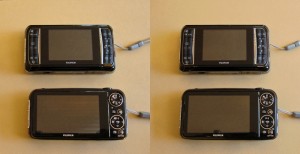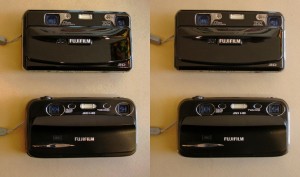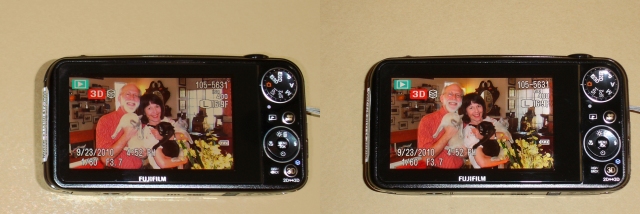On September 1, 2010 Fujifilm released their second digital 3-D camera for sale in the US market the FinePix Real 3D W3. This was less than a year from the September 30, 2009 release of the W1 first model. (Why there is no W2 model must be a marketing decision.).
There is a lot of good 3-D news to report about the new camera model.
First, the suggested retail price is about $100 less than the first model, at US$499.95.
Second, although the W1 was, and is, a great 3-D digital camera, Fujifilm seems to have taken their first year of experience to fine tune the design and specifications of the camera. There are mostly many small improvements.
Most notable is a large and sharper Autostereoscopic 3D Widescreen 3.5″ LCD display. This appears to be using a very fine lenticular screen. It is not only larger and sharper, but it is brighter, and easier to see outdoors. Still not great, but a lot more visible than the mirror-like screen of the W1 model.
The FinePix REAL 3D W3 is a step up from its predecessor with the ability to shoot high-resolution 3D photos and movies in 3D HD at 720p, with the help of a new RP (Real Photo) Processor. These play back nicely on the 16:9 ratio screen on the back of the camera.
The W3 also has a new Mini HDMI port for easy playback on most of the new HDMI 1.4 standard 3D television systems. (I’ve already found I can make this compatible with my older checkerboard 3-D format Mitsubishi DLP TV, using a $95 Model 3DA-1 adapter made by Mitsubishi). This is a smart move, as in the long run, easy playback on the new 3-D televisions may help drive both the sales of the 3-D cameras, as well as the sales of the 3-D TV’s (which do not have a lot of content available to purchase at the present time). With this in mind, Fujifilm has discontinued the V1 8″ autostereoscopic viewer. Although the new large 3-D TV screens require 3-D glasses, the images are a lot sharper and more spectacular!
The W3, same as the W1, uses twin 10 MegaPixel CCD sensors and dual FUJINON 3x optical zoom lenses (35-105mm). The lens spacing has been reduced by 2mm to 75 mm on the W3.
Although I’m now very used to the unique rocker-button controls of the W1, the new W3 camera now has much more conventional controls on the back, nearly identical to those found on most compact non-3-D digital cameras. (see photo)
A rotating Mode Dial is now used to set Auto, Advanced 2D, Advanced 3D, Programmed Auto Exposure, Aperture Priority Auto Exposure, or Manual speed and shutter setting modes. A familiar round selector button with a Menu/OK button in the center controls multiple functions, such as flash settings, delete, macro mode, self timer, and up/down/right/left cursor movement in system menus. There are separate buttons for playback, Movie Mode, 2D/3D mode, and Display/Back functions. On the top edge of the camera is a zoom ring around the shutter button, and a parallax control button.
All of this is now encased in a slightly lighter 9 ounce (250 gram) body that is also just a bit smaller and thinner than the W1. Part of this is achieved by using a smaller NP-50 battery, instead of the NP-95. This is one of my few negative points about the new model. The smaller battery has a noticeably shorter life. The camera now comes with a compact external battery charger.. I’ve found that the battery life indicators on both the W1 and W3 do not seem to be accurate. They can go from full, or partially full, to virtually depleted suddenly and unexpectedly. One or more spare batteries are definitely recommended. These can be found on Ebay quite easily.
The 720p HD 3-D movies look amazingly good on our 65″ DLP TV. I quickly discovered that the speed of the SD card makes a big difference when shooting in Movie mode. With a Class 4 SDHC card I found that after about 11 seconds of video the camera indicated “storing” and would stop. I’m assuming that this is because the speed of writing to the card could not keep up with the speed of the video. With a Class 6 card this did not happen. Although the larger cards can store more than 15 minutes (21 minutes of HD video on an 8GB card), the camera limits each “take” to 15 minutes. Be ready to start recording again after 15 minutes if you want to shoot longer films.
The body finish of the camera has been changed from highly glossy to a matte finish. This is much nicer, as it does not get visible fingerprints every time you touch it. An ergonomic ridge has been added to the slide-down cover, to make it easier to slide. The tripod socket on the bottom of the camera now appears to be metal. Hopefully this will wear better and longer than the tripod socket on the W1.
Overall I find the W3 to be a nice improvement over the W1 3-D camera. The only items that seem to be missing from the W3 that were on the W1, are the Infrared file transfer capability, and a built-in socket for operating the camera on AC power, or for charging the battery inside the camera. An optional adapter and charger is now needed to run the W3 camera on AC power, and an external battery charger makes dealing with the battery much simpler. The metal trim ring around the body of the camera has been changed from shiny chrome to shiny smoke colored metal. It is still slippery, and I wish they had changed this to the non-slip rubbery texture covering. The left lens still is very close to the upper left corner of the camera, so one has to be very aware not to get a finger in the picture. The W3 does away with clear protective covers over the lenses. This was the source of some complaints from W1 users, who felt that under certain conditions the protective plastic made the lenses more prone to some flare.
Along with all of the small improvements to the camera, there is now a BIG change in the marketing strategy. There was virtually no sales promotion of the W1 camera. In the USA it was sold ONLY online at shopfujifilm.com and NVIDIA’s web site.
With the W3 camera Fujifilm is finally making the camera available to the mass market, starting with it being available from Amazon.com. NSA members should note that it is also being sold at competitive prices by NSA members Ken Burgess & Tanya Alsip at www.cyclopital3d.com and Steve Berezin at www.berezin.com. The camera will (finally!) also be available at selected dealers all over the USA. Presumably marketing outside the USA will also be much more widespread than it was for the W1 camera.
So, if you’ve been undecided about buying the W1, at $100 less and with many improvements, the W3 might be the pocketable digital 3-D camera you’ve been waiting for.
If you already own a W1 camera note that most of the improvements are very small, and that for still 3-D images the specifications of both cameras are virtually identical. The main reasons to upgrade to a W3 are if you plan to shoot a lot of HD 3-D video, or you have a new 3-D TV that you’d like to play back your images on. 3-D playback is easy with the W3, but can still easily be done without using the camera for playback. Some TVs have SD card slots and built-in software to read the MPO files for playback. With other TVs, such as our Mitsubishi DLP TV, before we got the adapter we were still able to show 3-D images on the TV, by having a computer or laptop with HDMI output connected to the TV, and running StereoPhoto Maker in the proper playback mode for the TV.
Only one year ago it seemed like a dream to finally have a real, well-designed digital 3-D camera from a major manufacturer. A year later we have a new model on the market, as well as 3-D TVs, and at least one lower cost 3-D camera from China (the Aiptek).
The digital revolution has now embraced 3-D! I think it may be safe to say that we may expect more 3-D gadgets to come to market in the next few years.
DDDavid Starkman
Culver City, CA
Quick W3 versus W1 comparison
1. W3 is slightly thinner smaller and lighter.
2. W3 finish is matte rather than glossy. No fingerprints show on the body.
3. W3 has a larger screen. W3 is 3.5″ 16:9 ratio. W1 is 2.75″ 4:3 ratio. W1 screen uses different technology. W3 has one main good sweet spot, but in that spot the image is brighter and sharper than on the W1. Also slightly easier to see outdoors, but still difficult for composing in bright sun. Has a 1.5x brightness boost for outdoor viewing.
4. W3 has 720p HD video vs. 640×480 in the W1
5. W3 has a mini HDMI 1.4 output for direct 3-D connection to the new 3-D TVs.
6. W3 has conventional controls on the back of the camera. More intuitive and easier to use.
7. W3 has cheaper retail price than the W1. $500 or less in the USA. The W1 was $600.
8. W3 tripod socket appears to be metal. On the W1 it is not and we wore out the threads.
9. W3 reportedly has no toe-in on the lenses. 75mm base on W3 versus 77mm base on the W1. Supposed to focus closer than the W1.
10. Lenses on the W3 do not have an extra protective cover that introduces more reflections and glare. Should be less prone to haze than the W1.
11. To get a thinner body a thinner battery is being used on the W3. W3 battery life is shorter than on the W1. W3 uses an external supplied battery charger, which I personally like better than charging the battery while in the camera. Spare batteries may be charged while camera is in use. A shorter battery life is the only negative item I see so far. Have already bought after-market batteries very cheaply online via Ebay.
12. W3 does not have Infrared image transfer. This was a great feature on the W1 for sharing images instantly with other W1 users.
13. Bottom line. If you have not bought a digital 3-D camera yet, the W3 is well worth considering.




David:
It is a pleasure to read another of your excellent, thorough reviews. I have been reading them for years. I have two questions, related more to the memory cards than the camera itself, but likely still within your experince.
First, you mentioned that the camera stopped recording 3D video with a Class 4 card after 11 seconds (which was resolved with a Class 6 card). Was the Class 6 card tested at length or is it possible that a Class 6 card would stop recording after, say, 3 or 12 minutes. That is, would upgrading to a Class 10 card be a waste of money?
Second, the Fujifilm website says they “checked” the W3 using Sandisk brand cards. Were you testing with Sandisk? Several other brands are significantly cheaper. Can they be used or would you recommend staying with Sandisk? When buying Sandisk, am I just paying for the brand?
Any help will be appreciated,
Tim timcanta@yahoo.com
Hello ,
Thank for you comparison , I like it and it is complete.
Do you have allready extract point cloud from stereo images of the W3 ?
I would like to do it
thank you for your help
Bastien